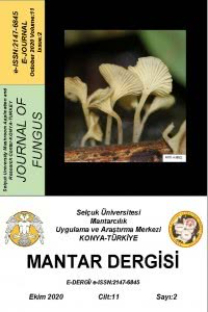Eskişehir İli Tarım Topraklarındaki Isıya Dirençli Toprak Mikrofunguslarının Biyoçeşitliliği
Isıya dirençli mikrogfunguslar, tarım toprakları, Eskişehir, çoklu gen sekansı
Biodiversity of Heat Resistance Soil Microfungi in Agricultural Areas of Eskisehir Province
___
- Altschul, S.F., Gish, W., Miller, W., Myers, E.W., Lipman, D.J. (1990). Basic Local Alignment Search Tool. J Mol Bio.; 215: 403-410.
- Amaeze, N.J., Ugwuanyi, J.O., Obeta, J.A.N. (2010). Studies of Heat Resistant Fungi in The Soil: Talaromyces flavus Isolated In Nigerian Soils, New York Science Journal, 3(12)
- Asan, A. (2004). Aspergillus, Penicillium, and related species reported from Turkey. Mycotaxon 89: 155-157.
- Aydın, A., Erkan, M.E., Ulusoy, B.H. (2005). Isıya dayanıklı küflerin gıda sanayii ve halk sağlığı açısından önemi, Gıda ve Yem Bilim Teknolojisi, 7, 28-35.
- Brown, J.C., (1958). Soil fungi of some British sand dunes in relation to soil type and succession. Ecology, 46, 641–664.
- Demirci, Ş.A, Arıcı, M. (2006). Margarinde yüksek sıcaklığa dayanıklı küflerin izolasyonu, tanımlanması ve ısıl dirençlerinin belirlenmesi, Journal of Tekirdag Agricultural Faculty, 3(3), 269-273.
- Demirel, R. (2016). Comparison of rDNA regions (ITS, LSU, and SSU) of some Aspergillus, Penicillium, and Talaromyces spp., Turkish Journal of Botany, 40: 576-583
- Glass, N.L., Donaldson, G.C. (1995). Development of primer sets designed for use with the PCR to amplify conserved gene from filamentous Ascomycetes. Appl. Environ. Microbiol. 61, 1323-1330.
- Houbraken, J. Samson, R.A. (2006). Standardization of methods for detecting heat resistant fungi, Advances in Experimental Medicine and Biology, 571, 107-111.
- Kikoku, Y., Tagashira, N., Nakano, H., (2008). Heat Resistance of Fungi Isolated from Frozen Blueberries, Journal of Food Protection 71 (10): 2030–2035. Klich, M. A. (2002). Identification of common Aspergillus Species, First edition, Utrecht, The Netherlands: Centraalbureau voor Schimmelcultures.
- Kocakaya Yıldız, A., Coksöyler, N. (2002). Heat-resistance characteristics of ascospores of Eurotium chevalieri isolated from apricot juice, Nahrung, 46,1, 28-30.
- Kumar, S., Stecher, G., Li, M., Knyaz, C., Tamura, K. (2018). MEGA X: Molecular Evolutionary Genetics Analysis across computing platforms. Molecular Biology and Evolution 35:1547-1549.
- Mouchacca, J. (2007). Heat tolerant fungi and applied research: Addition to the previously treated group of strictly thermotolerant species, World J Microbiol Biotechnol 23:1755–1770
- Samson, R.A., Houbraken, J., Thrane, U., Frisvad, J.C., Andersen, B. (2010). Food and Indoor Fungi. Utrecht, the Netherlands: CBS KNAW Fungal Diversity Centre.
- Samson, R.A., Yilmaz, N., Houbraken, J., Spierenburg, H., Seifert, K.A., Peterson, S.W., Varga, J., Frisvad, J.C. (2011). Phylogeny and nomenclature of the genus Talaromyces and taxa accommodated in Penicillium subgenus Biverticillium. Stud Mycol 70: 159-183.
- Samson, R.A., Visagie, C.M., Houbraken, J., Hong, S.B., Hubka, V., Klaassen, C.H.W., Perrone, G., Seifert, K.A., Susca, A., Tanney, J.B. et al. (2014). Phylogeny, identification and nomenclature of the genus Aspergillus. Stud Mycol 78: 141-173.
- Schoch, C.L., Seifert, K.A., Huhndorf, S., Robert, V., Spouge, J.L., André Levesque, C., Chen, W. (2012). Fungal Barcoding Consortiuma, Nuclear ribosomal internal transcribed spacer (ITS) region as a universal DNA barcode marker for Fungi. Proc Natl Acad Sci 109(16):6241-6.
- Serra, R., Caban˜ es, F.J., Perrone, G., Castella, G., Venancio, A., Mule, G., Kozakiewicz, Z. (2006), Aspergillus ibericus: a new species of section Nigri isolated from grapes. Mycologia 98, 295–306.
- Tamura, K, Nei, M. (1993). Estimation of the Number of Nucleotide Substitutions in the Control Region of Mitochondrial DNA in Humans and Chimpanzees. Molecular Biology and Evolution, 10:512-526.
- Valík, L., Piecková E., (2001) Growth modelling of heat-resistant fungi: the effect of water activity, International Journal of Food Microbiology. 63 11–17 White, T.J., Bruns, T., Lee, S., Taylor, J. (1990). Amplification and direct sequencing of fungal ribosomal RNA genes for phylogenetics”, (Ed. Innis M.A., Gelfand, D.H., Sninsky, J.J., White, T.J.) PCR Protocols: A Guide to Methods and Applications, Academic Pres, USA
- Yaguchi, T., Imanishi, Y., Matsuzawa, T., Hosoya, K., Hitomi, J. (2012). Nakayama M., Method for Identifying Heat-Resistant Fungi of the Genus Neosartorya, Journal of Food Protection, 75 (10): 1806–1813.
- http://www.refgen.com (01.12.2019)
- https://blast.ncbi.nlm.nih.gov/Blast.cgi (01.12.2019)
- http://www.indexfungorum.org/names/names.asp (01.12.2019)
- ISSN: 2147-6845
- Yayın Aralığı: Yılda 2 Sayı
- Başlangıç: 2010
- Yayıncı: Selçuk Üniversitesi Mantarcılık Uygulama ve Araştırma Merkezi Müdürlüğü
Nezahat Gökyiğit Botanik Bahçesi'nin Mikrofungusları I.: Yeni Familya ve Tür Kayıtları
Tarım Topraklarındaki Isıya Dirençli Fungusların Belirlenmesi Üzerine Ön Çalışma
Küresel Gıda Güvenliği Riski: Ug99 Kara Pas Irkı
Türkiye’de Pleurotus ostreatus Üreticilerinin Karşılaştığı Sorunlar ve Çözüm Önerileri
Butyriboletus fuscoroseus; Türkiye Mikotası için Yeni Bir Boletoid Makrofungus Kaydı
Hakan ALLİ, İsmail ŞEN, Roni Aran ADIBELLİ
Bahar Gülce KORKMAZ, Göksu CEYLAN, İbrahim SARI, Burak Nuri ACAR, Mustafa YAMAÇ
Desarmillaria tabescens’in in vitro Antimikrobiyal Aktivitesi
Kerem CANLI, Atakan BENEK, Merve ŞENTURAN, İlgaz AKATA, Ergin Murat ALTUNER
Konya Selçuk Üniversitesi Hastanesi’ne Başvuran Hastalarda Saptanan Dermatofitler
